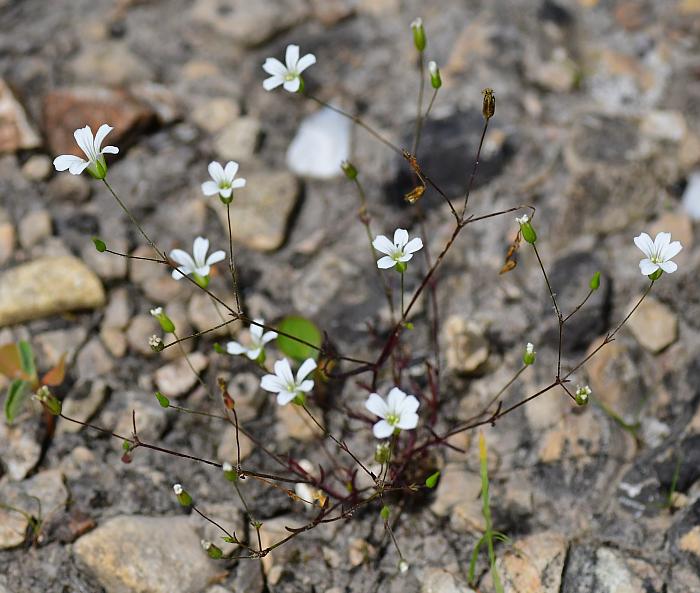Mononeuria patula (Michx.) Dillenb. & Kadereit
Sandwort

Native
CC = 7
CW = 5
MOC = 48
© SRTurner
Mononeuria patula (Michx.) Dillenb. & KadereitSandwort | |
 |
Native CC = 7 CW = 5 MOC = 48 |
© SRTurner |
|
Family - Caryophyllaceae Habit - Annual forb from fibrous roots.
Stems - Ascending to erect, to 30 cm, slender, often multiple from base, not matted, unbranched or dichotomously branched, glabrous or sometimes sparsely pubescent with short, stalked glands.
Leaves - Opposite, simple, sessile, mostly widely spaced and not overlapping, lacking axillary clusters of leaves. Leaf blades 0.2-2.0 cm long, 0.5-1.5 mm wide, narrowly linear to linear, soft and herbaceous, angled to a bluntly or sharply pointed but not spinelike tip, green or purplish-tinged, glabrous.
Inflorescence - Terminal loose cymose panicles, the stalks 0.3-3.0 cm long, glabrous or sparsely pubescent with short, stalked glands, the bracts with green margins.
Flowers - Sepals 5, 4.0-5.5 mm long, not becoming elongated at fruiting, the lobes narrowly to broadly lanceolate, narrowly angled or tapered at the tip, the surface with 5 prominent nerves or ridges. Petals 5, 5-9 mm long, white, glabrous, broadly notched at the tip. Stamens 10. Filaments 2 mm long, filiform, glabrous, white. Anthers yellow, 0.4 mm long. Ovary ovoid, glabrous, 1.1 mm long, 0.8mm in diameter. Styles 3, 1 mm long, glabrous, white.
Fruits - Capsules 3.0-4.2 mm long, shorter than the calyx. Seeds 0.4-0.6 mm wide, the surface tuberculate, reddish brown to black, not shiny.
Flowering - March - May. Habitat - Glades, ledges and tops of bluffs, sandy or rocky upland forest openings, upland prairies, roadsides. Origin - Native to the U.S. Lookalikes - Sabulina michauxii, also large-flowered species of Cerastium, such as C. arvense. Other info. - This little plant is found in most counties south of the Missouri River. Beyond Missouri its natural range is largely within the U.S. Midwest, in two somewhat disjunct regions. When not in flower the plant is easy to overlook because it is so small and has very thin stems. While in flower the small white corollas are easy to spot, at a glance appearing suspended in midair. The glade habitat, flower appearance, and thin stems with tiny linear leaves are good clues to identity. This species is very short-lived but the dead stems can be found throughout the year. Photographs taken in Lebanon, TN., 5-16-03, and at Dave Rock Conservation Area, St. Clair County, MO., 6-7-03 (DETenaglia); also at Drury-Mincy Conservation Area, Taney County, MO, 4-14-2012, Valley View Glade Natural Area, Jefferson County, MO, 5-6-2018, and Shaw Nature Reserve, Franklin County, MO, 5-1-2021 and 5-17-2022 (SRTurner). |